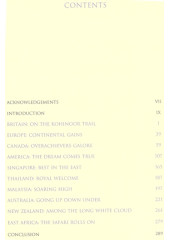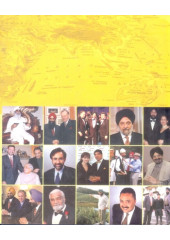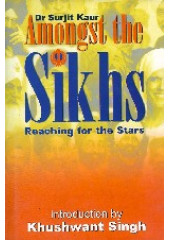Monday to Saturday - 10:00 Am to 9 PM
Now Enjoy Bulk Discounts on Books as Mentioned Below
These Discounts are in addition to the Discounts on Individual Books (Visible as Bulk Discount for Books in Cart)
Extra 10% Off If Books Purchased Exceeds Rs 3000 or 75 USD or 60 GBP or 60 Euro or 100 AUD or 100 CAD
Extra 15% Off If Books Purchased Exceeds Rs 6000 or 150 USD or 120 GBP or 120 Euro or 200 AUD or 200 CAD
Extra 20% Off If Books Purchased Exceeds Rs 15000 or 225 USD or 180 GBP or 180 Euro or 300 AUD or 300 CAD
Extra 25% Off If Books Purchased Exceeds Rs 30000 or 300 USD or 240 GBP or 240 Euro or 400 AUD or 400 CAD
Table of Contents of the Book 'The Rise of Sikhs Abroad' By Gurmukh Singh
| C O N T E N T S | |
| ACKNOWLEDGEMENTS | VII |
| INTRODUCTION | IX |
| BRITAIN: ON THE KOHINOOR TRAIL | 1 |
| EUROPE: CONTINENTAL GAINS | 39 |
| CANADA: OVERACHIEVERS GALORE | 59 |
| AMERICA: THE DREAM COMES TRUE | 107 |
| SINGAPORE: BEST IN THE EAST | 165 |
| THAILAND: ROYAL WELCOME | 187 |
| MALAYSIA: SOARING HIGH | 197 |
| AUSTRALIA: GOING UP DOWN UNDER | 221 |
| NEW ZEALAND: AMONG THE LONG WHITE CLOUD | 261 |
| EAST AFRICA: THE SAFARI ROLLS ON | 279 |
| CONCLUSION | 289 |
Introduction to the Book 'The Rise of Sikhs Abroad' By Gurmukh Singh
This stock-taking coffee-table travelogue highlights the rise to prominence of Sikh communities around the world. It is a riveting account of how Sikhs,. who started emigrating from Punjab towards the end of the nineteenth century, today occupy a place of pride in their adopted lands. Packed with the latest information, this book sketches the lives of some of the most prominent Sikhs in various fields and gives an accurate idea of how in just one century Sikhs have become a global community.
'No self-image of India can be complete without a reference to its diaspora. Contrary to the myth that we Indians have been reluctant to travel abroad, a good part of our history is enacted outside India. The role of the Indian diaspora in mediating between India and the world and in shaping each's perception of the other needs to be fully appreciated than is the case at present. The Karmabhoomi of Indians is as much at home as outside it; there are many little and large Indias outside India, and part of India lies outside its territorial boundaries. It was only this January (2003) that this aspect of Indian identity was publicly acknowledged and celebrated.' ---------------- Lord Bhiku Parekh
True. With India deciding to grant dual citizenship to Non-Resident Indians from a few developed countries and celebrating 9 January as Parvasi Bharati Divas every year, the imporance of the 20-millon Indian diapora certainly assumes a vital significance in nation-building.
The accomplishments of overseas Indians are astounding and inspirational. Since one volume could not have done justice to them, this book focuses only on one segment: the Sikhs. They constitute about 40 per cent of the Indian diaspora in the US, 70 per cent in Canada and 40 per cent in Britain.
The attacts on them in America, Australia and elsewhere after the 11 September 2001 terror strikes in New York and Washington only brought them into sharp focus. With their flowing beards and turbans, the Sikhs were mistaken for Arab Muslims and subjected to racial attacks. These incidents highlighted the fact that Sikhs are a global community today. As scholar E.J.B. Rose says, 'The Sikhs are perhaps the most mobile and versatile people in the whole of India.'
Anthropologist Verne A. Dusenbery, in his book titled The Sikh Diaspora: Migration and the Experience Beyond Punjab, adds, 'The Sikhs are people willing to pursue opportunities anywhere in the world to make a better life for themselves and their families. Indeed while the Punjab, the historical birthplace of the Sikh Panth, remains the Sikh "heartland", perhaps a third of the world's Sikhs (numbering more than 2.5 million today) have made their temporary or permanent residence outside Punjab.'
Why do the sons of Punjab keep looking for greener pastures abroad?
For centuries, they had faced invaders from Central Asia. The saying 'Punjab de jamiyan nu nit muhiman', (Punjab-born are condemned to be on the war campaign), can be traced to these uncertain times.
Nature has equipped the Punjabi well. The invasions from the northwest only helped develop his physical strength. Punjabi folklore is replete with the exploits of the likes of wrestler Gama.
His carefree nature has made the Punjabi a romantic as also receptive to new ideas. He is endowed with an unparalleled sense of humour.
Not surprisingly, the world's funniest gag (out of 40,000 received from 70 countries) in the year 2002 was coined by a British Sikh, Gurpal Gossal. The gag runs like this: Two hunters are out in the woods when one of them collapses. He doesn't seem to be breathing and his eyes are glazed . The other guy whips out his cellphone and calls the emergency services. He gasps, 'My friend is dead ! What can I do ?' The operator says, 'Calm down, I can help. First, let's make sure he is dead.' There is a silence, then a shot is heard. Back on the phone, the guy says, 'OK, now what ?.'
This trait manifested itself in the legendary love stories of Heer-Ranjha, Sohni-Mahiwal, Sasi-Punnu and Mirza-Sahiban. And it manifested itself in an exploratory streak.
Panini wrote the world's first treatise on Sanskrit grammar and Valmiki wrote the Ramayana on Punjab soil. The Rig Veda was written on the banks of the river Beas.
The Buddha found the Punjab of his time spiritually and intellectually fertile and sent his disciples to the Land of the Five Rivers, as Punjab is also Known, to 'explore and experiment' in search of new ideas. Consequently, Buddhism spread in Punjab (including today's Pakistan and Afghanistan). Buddhist centres of learning came up in different places, including the world's first university at Taxila (now in Pakistan).
Punjab also proved to be the turning point for Alexander the Great who was on his mission to conquer the world. He abandoned his campaign after his verbal duel with the defeated Punjab king, Porus. When Porus was produced before Alexander, he was asked how he should be treated. Porus said: 'The way one king should treat another.'
Once Alexander saw some Brahmins engaged in an animated discussion among themselves. They completely ignored him. When he questioned them about their discussion, they replied : 'King Alexander, every man can possess only so much of the earth's surface as this we are standing on. You are but human like the rest of us, save that you are always busy and up to no good, travelling so many miles from your home, a nuisance to yourself and to others. Ah, well ! You will soon be dead, and then you will own just as much of this earth as will suffice to bury you.'
In Taxila, Alexander also met members of the Indian sect of Wise Men who walked around naked. He admired their powers of endurance so much that he decided to take one of them with him. The oldest man among them, whose name was Dandamis (the others were his pupils), refused either to join Alexander or to permit any of his pupils to do so. 'If you, my lord,' he is said to have replied, 'are the son of God ----so am I. I want nothing from you, for what I have is sufficient. I perceive, moreover, that the men you lead don't get much from their worldwide wandering over land and sea, and that of their many journeys there will be no end. I desire nothing that you can give me; I fear no exclusion from any blessings which may perhaps be yours. India, with the fruits of her soil in due season, is enough for me while I live; and when I die, I shall be rid of my poor body.'
Alexander is said to have shaken his head and remarked: 'What a race ! Both the king and the ascetic are speaking the same language !' And he retreated.
In fifteenth-century Punjab rose the religion of Sikhism. Its pacifist founder, Guru Nanak, preached equality of men and oneness of God, challenged the casteist and feudal system, and wrote lyrical poetry in praise of God.
The last Sikh guru, Gobind Singh, turned Sikhs into a martial race to challenge the mighty Mughal Empire. The valiant Sikhs took on the invaders from across the Khyber Pass. Later, Maharaja Ranjit Singh, who was coronated in Lahore in 1802, went on to establish the great Sikh secular empire. The tide of inward flow into Punjab was stemmed forever.
The outward flow (from Punjab) began in the nineteenth century when the British took over Punjab in 1849, (the last Indian bastion to fall to the British), and absorbed the Khalsa Army into the British forces. Sikh soldiers were sent to guard British interests in Singapore, Malaya, Hong Kong and Burma. Later, the famine in the 1860s further worsened conditions, forcing people to seek opportunities abroad.
When the anti-colonial feeling grew in India, particularly after the Jallianwala Bagh (Amritsar) massacre in 1919, many Sikhs went abroad to champion India's cause. (More than eighty per cent of those who went to the gallows during British rule were Sikhs.)
Indentured labour and artisans headed for East Africa to build railroads. Most Sikhs in East Africa moved to Britain when Kenya became independent in 1963, and Idi Amin expelled them from Uganda in 1972-73.
Some Sikh traders went to Thailand in the last decade of the nineteenth century.
The first Sikh to set foot on British soil was Maharaja Duleep Singh, the son of legendary Maharaja Ranjit Singh, after the fall of the Sikh Empire in 1849. Then followed Sikh traders, and students persuing higher studies. Immigration into Britain picked up after the Second World War. Today, there are more than half a million Sikhs in Britain. There is a fair sprinkling in Germany, Holland , Denmark , Sweden, Norway, Switzerland, Itlay and Belgium as well.
Sikh influx into North America began towards the end of the nineteenth century when Hong Kong-based Sikh soldiers in the British Army passed through Canada following Queen Victoria's Diamond Jubilee in London in 1897. They saw huge farming opportunities in Canada. On retirement from the British Army, many boarded ships to San Francisco or Vancouver. Impoverished farmers from Punjab followed their trail. Then came in students and Ghadar Party revolutionaries.
Sikh immigrants worked on farms in California and in sawmills in Canada. As their numbers swelled, laws were enacted to keep them out. When the US and Canada granted them citizenship rights in 1947, a new phase in Sikh immigration was inaugurated.
By 2002, there were more than a million Sikhs in North America.
A number of Sikhs reached Australia and New Zealand in the nineteenth century. Their number has increased manifold, particularly since the 1970s.
In the first year of the new millennium, there were about 15,000 Sikhs in Australia and about 4,000 in New Zealand.
If the early Sikhs were security guards and watchmen in East Asia and East Africa; lumberjacks and farm hands in North America; and cameleers, hawkers and cane cutters in Australia; the contemporary Sikhs are breaking all barriers to reach the top in all professions.
Canada's Herb Dhaliwal is the first South Asian to become a federal minister anywhere in the western world. Ujjal Dosanjh created history in February 2000 by becoming the first-ever coloured premier in Canada, and the western world. Gurbux Malhi is the first turban-wearing member of any parliament in the West.
Didar Singh Bains of Northern California is one of the world's largest producers of peaches. Darshan Singh Dhaliwal is one of the biggest gas station owners in America.
Yogi Harbhajan has spread the Sikh message in the western hemisphere.
Mota Singh is Britain's first Asian and Sikh judge. When he first won in 1992, Piara Singh Khabra was the first Sikh member of parliament in Britain. Today, Marsha Singh and Parmjit Dhanda are other two Sikh MPs in the British House of Commons. Tarsem King is the first Sikh Lord.
Sant Chatwal of New York owns the largest number of hotel rooms in Manhattan, and the famous Bombay Palace chain of restaurants. Inder Singh of Los Angeles heads the largest body of Non-Resident Indians -----the Global Organization of the People of Indian Origin (GOPIO). Dr. Amarjit Singh Marwaha, who was one of the first Indian doctors to land in the US in the 1950s, in one of the most famous Sikhs of Los Angeles.
Sanjeev Sidhu is considered one of the richest Indians in the US. Dr. Manjit Singh Bains of New York is one of the best lung cancer specialists in the US. Dr. Narinder Kapany is called the 'czar' of fibre optics in California.
Sitarist Harvinder Singh of Stockholm is a world famous exponent of Indian and western classical music. Tiger Jeet Singh's son, Tiger Ali Singh, was the first Asian face on the World Wretling Federation (WWF). Kartar Singh Thakral of Singapore is one of the richest Sikhs in the world.
Choor Singh Sidhu was the first Sikh judge in Singapore. Inderjit Singh and Devinder Singh are two Sikh members of parliament in Singapore. Sarwan Singh Gill was the first Sikh chief justice of Malaysia. Karpal Singh is the topmost lawyer and the deputy leader of the Opposition in Malaysia. Mahima Singh was the first MP to be elected in the first-ever elections in independent Malaysia.
Pritam Singh is the 'Keeper'of the Sikh community in Indonesia. Dr Inderjit Singh Virdi is rated as one of the top five cardiologists in Australia. Gian Singh Bains is one of the richest cane farmers Down Under.
What do these women ------ Neena Gill, first Indian-born member of the European Parliament; Ajit Tiwana, first South Asian woman to join the Royal Canadian Mounted Police; Sukhi Turner, mayor of Dunedin City in New Zealand; Kavelle Bajaj, among the top fifteen women entrepreneurs in the US; Kanwaljit Soin, first nominated member of the Singapore Parliament and first woman surgeon of Singapore; Gurinder Chadha, known film maker in England; and Amrita Cheema, a known face on German television -----have in common? It is their Sikh roots.
And the diaspora is full of rags-to-riches stories. Kanwal Rekhi, who is known as the sage of Silicon Valley, was thrown out of three jobs before he found his calling. Sonny Chabra, who owns a multimillion-dollar software company in New York, once sold jeans on the pavements in Manhattan.
Jessie Singh, who is worth millions in Silicon Valley today, was once a pizza delivery boy. Gary Singh, who is a top-notch broker in Toronto, used to work as a security guard to pay his university fees.
Tony Deep Wouhra, who owns the multi-million pound East End Foods in Britain, once sold eggs on the streets of London.
Ajit Singh, who became the first Sikh civil servant in Malaysia and the first secretary general of the Association of South East Asian Nations (ASEAN), rose from a log cabin. Herb Doman, who is Canada's richest Sikh, toiled for ten cents an hour as a fourteen-year-old kid.
Indeed, the Sikh diaspora has made strides of continental proportions. There are many Punjabs away from Punjab: Southhall in London, Yuba City in California, Woolgoolga in Australia, and Surrey in British Columbia. Punjabis have become truly global.
This is not an exhaustive list by any means, but an attempt has been made to capture the diaspora's changing profile in the contemporary world. The focus is entirely on those countries where Sikhs are growing in numbers.
About the Author 'Gurmukh Singh' of the Book 'The Rise of Sikhs Abroad'
A Bachelor of Mass Communication from Panjab University, Chandigarh, Gurmukh Singh joined The Times of India, Jaipur, as a trainee in 1985. During his 17 year career, he has travelled all over India and written on politics, sports, music and social issues. As part of this project, he travelled all over the world to get first-hand information on the state of the community.
| Books | |
| Author | Gurmukh Singh |
| Pages | 288 |
| Cover | Hardbound |
| Language | English |
The Rise of Sikhs Abroad - Book By Gurmukh Singh
- Brand: Rupa Publications
- Product Code: CFT122
- Availability: In Stock
-
Rs.2,500.00
Related Products
Amongst The Sikhs - Book By Dr. Surjit Kaur
Introduction of The Book ‘Amongst The Sikhs’ By Dr. Surjit Kaur The landing of the firs..
Rs.595.00
Dictionary of Sikh Names - Book By Parmit Kaur Chilana , Rajwant Singh Chilana
From The Backcover Of 'Dictionary of Sikh Names' By Parmit Kaur Chilana - Rajwant Singh Chilana ..
Rs.225.00
The Sikhs - Book By Khushwant Singh
Introduction To Book "The Sikhs" By Khushwant Singh The Sikhs are culturally one of the richest c..
Rs.2,500.00
Sikhism - A Guide For The Perplexed - Book By Arvind Pal Singh Mandair
Table of Contents For 'Sikhism A Guide For The Perplexed' By Arvind Pal Singh Mandair List ..
Rs.299.00
The Sikhs - Book By Dr. Baldev Singh Baddan
Introduction To 'The Sikhs' By Dr. Baldev Singh Baddan Guru Nanak was the only Hindu re..
Rs.100.00
Return To Empire - Punjab Under The Sikhs And British In The Mid-Nineteenth Century - Book By Andrew J Major
From The Frontcover Of 'Return To Empire - Punjab Under The Sikhs And British In The Mid-Nineteen..
Rs.400.00
The Sikhs and The Sikh Wars
From The Backcover Of 'The Sikhs and The Sikh Wars' By Charles Gough and Arthur D. Innes ..
Rs.495.00
Tags: books on sikh success stories, buy book rise of sikhs abroad, buy books gurmukh singh, inspirational sikh stories, progress of nri sikhs the, coffee, table, sikhism












